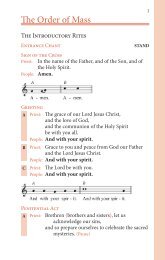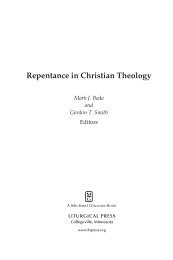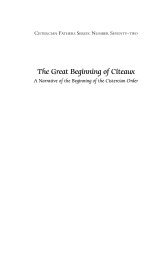“Fritz West, himself a methodological master of ... - Liturgical Press
“Fritz West, himself a methodological master of ... - Liturgical Press
“Fritz West, himself a methodological master of ... - Liturgical Press
Create successful ePaper yourself
Turn your PDF publications into a flip-book with our unique Google optimized e-Paper software.
allowing for inference and may, in that sense, be regarded as corollaries<br />
<strong>of</strong> the first. 42<br />
The organic model was also helpful to Baumstark for organizing<br />
data. Of course, all scholars <strong>of</strong> the early liturgy must take into account<br />
Jewish, Christian, and Hellenistic contributions to the development<br />
<strong>of</strong> the liturgy. For the Roman Catholic scholar <strong>of</strong> the early twentieth<br />
century, however, these three could not be simply analogous historical<br />
forms <strong>of</strong> human invention, comparable to all other such forms in<br />
an unbroken series <strong>of</strong> equal entities. From a doctrinal point <strong>of</strong> view,<br />
Catholic Christian liturgical forms were by (super)nature incomparable,<br />
rooted as they are in the historical particularity <strong>of</strong> the incarnation;<br />
the Eucharist was understood to be essentially different from a<br />
Jewish Sabbath meal or a Hellenistic symposium. For this reason, the<br />
Catholic scholar had to be able to (1) assert the integrity <strong>of</strong> the liturgy<br />
<strong>of</strong> the Church and (2) weight the factors that shaped it so as to maintain<br />
the unique character <strong>of</strong> the incarnation. The ontological organic<br />
model served Baumstark well in this regard. With its bias in favor <strong>of</strong><br />
the internal life <strong>of</strong> the liturgical “organism,” its genetic understanding<br />
<strong>of</strong> the relationship to Judaism, and its categorization <strong>of</strong> the Hellenistic<br />
cultural milieu as mere “environment,” the ontological organic model<br />
examined the Church’s liturgy in its historical context while maintaining<br />
its distinctive character. 43 Within this <strong>methodological</strong> framework<br />
Baumstark found the freedom to exercise his craft, without compromising<br />
the historical particularity <strong>of</strong> Christian revelation. 44<br />
The ontological organic model organized data within the cultural<br />
organism as well. Already as a student <strong>of</strong> philology, Baumstark recognized<br />
that his teachers regarded cultural products <strong>of</strong> Christianity in<br />
the Near East, notably Christian literature, as derivatives <strong>of</strong> European<br />
forms. Baumstark wished to value Christian matters <strong>of</strong> the Near East<br />
in their own right. 45 Once again Baumstark and Strzygowski found<br />
themselves in the same camp. When Strzygowski argued that influences<br />
in the world <strong>of</strong> Anatolian art flowed from the East to the <strong>West</strong>,<br />
42 For a discussion <strong>of</strong> Baumstark’s liturgical laws, see <strong>West</strong>, Anton Baumstark’s<br />
Comparative Liturgy, 281–95.<br />
43 In addition to chaps. 2–4 in Baumstark, On the Historical Development, see<br />
also, for example, Baumstark, Comparative Liturgy, 2–14 and 63–70.<br />
44 <strong>West</strong>, Anton Baumstark’s Comparative Liturgy, 268–71.<br />
45 Baumstark, “Besprechung: Hilgenfeld, ed. Ausgewählte Gesänge des Giwar-<br />
gis Warda von Arbel,” OC 4 (1904): 209.<br />
14






